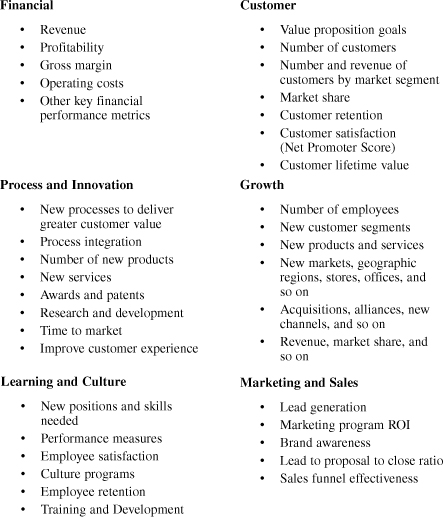10. Measurable Goals Drive Success
The goals in your marketing plan will describe very specific objectives you want to achieve as a result of implementing your marketing plan. The marketing plan goals should tie back to the overarching goals of the company to create alignment and momentum. Be as specific as possible when describing your goals so they are measurable. Follow a framework to create SMART goals, which are Specific and Measurable, Motivating, Achievable, Relevant, Trackable and Time-bound, as described below:
• Specific and Measurable: State your goals in a way they can be measured. Break big goals down into manageable chunks so you can define the steps to achieve big goals.
• Motivating: Describe goals that you want to achieve and can achieve. People excel when they do things they like. As goal achievement is delegated to employees in your company, the goal should also motivate them, so it’s important that they understand their role in achieving the goal. Consider tying performance measures to the goal as incentive.
• Achievable: Describes goals that are realistic yet challenging to you and your team. Nothing is more de-motivating than having a goal that is completely unrealistic.
• Relevant: Define goals that drive short-term objectives like revenue as well as goals that are congruent with the long-term vision. Both short-term and long-term must be balanced.
• Trackable and Time-bound: Define the timeframe each goal must be completed, as well as how it will be tracked, measured, and reported. If possible, state who is responsible for the goal (this could be a person, department, division, or region). For large overarching goals, you may want to consider assigning an executive sponsor.
To achieve a short-term plan, it’s important to state very specific goals and milestones. Consider how the 80/20 rule (Pareto principle) drives most businesses. If 80 percent of your revenue comes from 20 percent of your customers, then it’s critical to focus goals on that 20 percent of your customer base.
To balance both long-term and short-term goals, you will define one-, two-, and three-year goals. Obviously there will be more detail developed for one-year goals, but your marketing plan should also include long-term growth strategies. Your strategy should have consistency while remaining fluid and responsive to changing market conditions.
The Balanced Scorecard Goal Framework
The Balanced Scorecard is an effective framework for categorizing goals into financial, customer, process, and culture segments. Section VI, will explain how you can use the Balanced Scorecard (BSC) framework to align activities to achieve your goals. For now, I would like you to think about your goals in each of the four overarching goal categories used in the BSC:
• Financial: Think long-term and short-term. What are the revenue and profitability goals related to growth? What are the cost containment goals?
• Customer: What is the value provided to the target segments of customers?
• Internal Processes: What processes must be in place to deliver value to customers?
• Learning and Growth: What skills do people need to implement the processes? How will culture inspire employees to deliver extraordinary value to customers?
Goal Categories
In addition to the BSC categories, additional categories are listed below for you to consider, such as business growth and specific marketing and sales categories. Please customize the goals to correspond to the needs of your business. Write your goals using the SMART framework described earlier. When you have finished, edit the list to select and prioritize those that will have the most impact on business success. Fewer goals result in more focus. Summarize the goals in the marketing plan template.
If you have a small company you can group all your goals together. If you work in a large company, you may wish to divide goals (and your plan) by divisions, product and service lines, or geographic regions.

As you develop your marketing plan, your goals will change and evolve because you will learn more about the market. This section will also be fluid as you develop your plan, so don’t worry about writing “perfect” goals before moving on to the next section. In Section VI, you will review and evaluate the goals you are creating now to make sure they are still relevant based upon what you have learned during the course of writing the plan.
